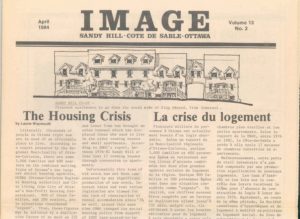Ken’s Bygone Sandy Hill
Building the community with innovative housing
Ken Clavette
I moved to Sandy Hill from Centretown in the summer of 1981. That first Halloween, I sat outside waiting for the kids to come by. It was a cold October, and I froze waiting in vain for them to show up. Then in 1983, news came that the many vacant lots and run-down houses owned by the University of Ottawa were to be developed into much needed housing for students and the community.
As part of that plan, uOttawa partnered with community members who wanted to build not-for-profit housing on university-owned land. One of those projects was the Sandy Hill Housing Co-operative (SHHC), which received a funding commitment in April 1984 for 64 units. SHHC came to an agreement with the university for a lease of the unused land and several of their still-standing houses. The neighbourhood was about to change. The goal of SHHC was to create housing that would bring a balance of young people, families, and seniors into the southwest end of Sandy Hill bordering the campus.

“The Housing Crisis” was the IMAGE headline in April 1984 and spoke to the situation at the time. The waiting list for affordable not-for-profit housing was growing ever longer. The market rents of the day may sound unbelievable to today’s readers: bachelors for just under $300, one-bedroom apartments for $400, and two-bedrooms renting for $560-$575. The vacancy rate was 2% and these rents were accounting for over 40% of people’s net income.
The teamwork of the community, the federal government, and the University of Ottawa joining to build rent-to-income housing was a step in the right direction in dealing with Sandy Hill’s lack of housing. Construction on the SHHC began later that year. Thirty-eight years later, our neighbourhood is a much richer place because of that partnership.
When the St. Georges Housing Co-operative was established on Henderson Avenue in 1992, it followed the partnership example set up by the SHHC. That co-op saved several uOttawa-owned heritage homes from demolition, which helped preserve the historic feel of Sandy Hill. Both co-ops bring life and vibrancy to an area that once felt abandoned. There was also a major change come Halloween that continued for decades afterwards, with many more children now living in and around Somerset, Osgoode, and Henderson.

Photo supplied by SHHC
In 2022, there remain original members still living in the SHHC. They moved in and aged into seniors in our community. Mature students settled down and raised families here. With housing charges based on income, many people who otherwise could not afford to live in Sandy Hill today continue to do so because they are supported by their neighbours.
In 2024, the land lease between uOttawa and the SHHC expires; it is my hope that for years to come the community will continue to benefit from such a unique partnership with a public institution like the university — using land they own but don’t need for education, but are willing to dedicate to affordable housing.
Similar news stories are being repeated in 2022: “Vacancy rate in Ottawa close to zero for those needing affordable housing” read one headline this past spring. The federal government budget has once again established funding for co-operative housing — could Sandy Hill benefit?
I hope my “Bygone Sandy Hill” column never has to be about how Sandy Hill was once home to innovative not-for-profit housing co-ops but no longer is.

Photo supplied by SHHC
